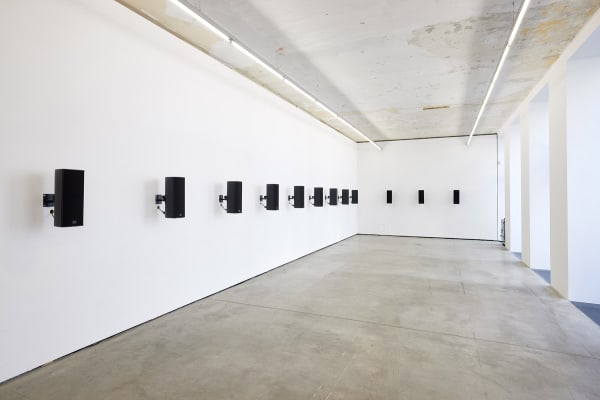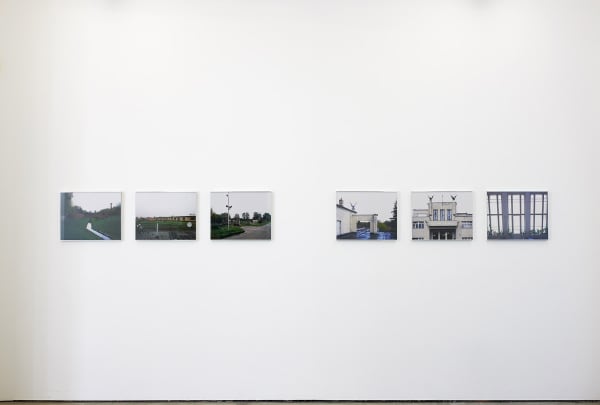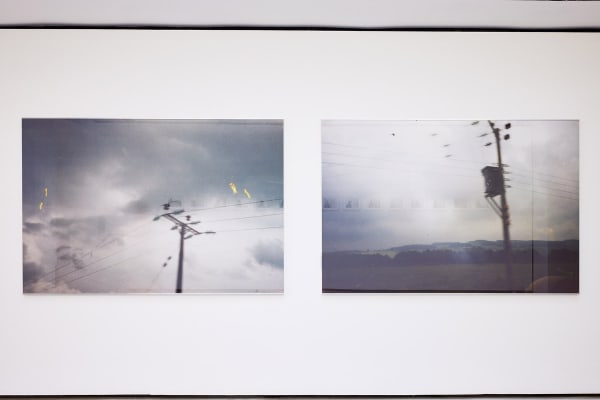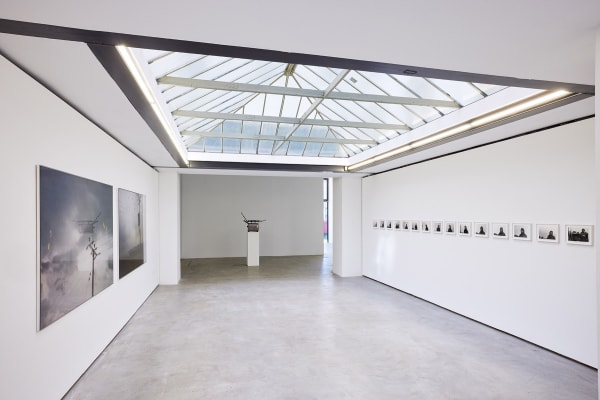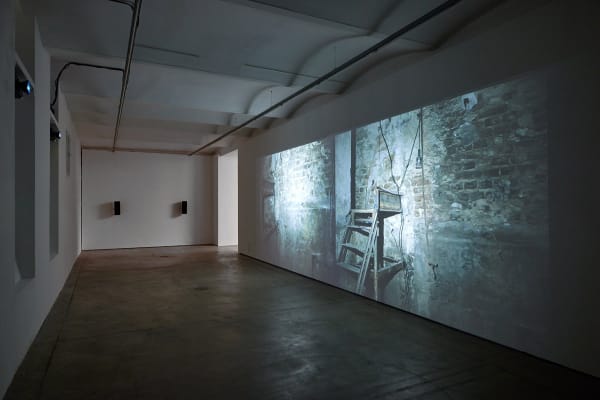With her site-specific sound installations on themes such as displacement, loss and memory, Scottish artist Susan Philipsz (born in Glasgow in 1965) is one of the outstanding artists of our time. For her exhibition in Vienna, she has combined sound installations and sound sculptures with films and photographic works to create an atmospheric space of remembrance that also reflects the architectural features of the exhibition venue and its history.
Her work Sound Mirrors, conceived especially for the exhibition, recalls the early decades of the building at Franz-Josefs-Kai 3. Built in 1904 by architect Julius Goldschläger, the building served as the residence of the Jewish Schwadron family and housed the offices of their renowned ceramic tile company Brüder Schwadron in what are today's exhibition spaces. The work merges the visual self-perception of visitors and the spatial experience of the architecture with the original preserved tiled ceiling via two parabolic mirrors, while the artist's voice echoes between them. Being in sound becomes a sensitive being in oneself.
Sound Mirrors is also the title of Susan Philipsz's double vinyl record, which is being released as a limited edition to coincide with the exhibition.
Bringing to mind the past is a constant in Philipsz's work – in particular reflecting on the remembrance of the Second World War and the havoc it wreaked on the culture. Along with other works in the exhibition, her 12-channel sound installation Study for Strings (2012) and the film installation Sokol Terezín (2023) are exemplary of this approach. Both draw on an orchestral work that Czech-Jewish composer Pavel Haas created in the Terezín / Theresienstadt concentration camp before he was murdered in Auschwitz. His Study for String Orchestra made its debut as part of a Nazi propaganda film documenting the supposedly good living conditions of European Jews in the ghetto. Philipsz's sound installation and her film, which takes us through extant rooms of the former ghetto, are based on instrumental sequences the artist has isolated, note by note, from Haas's composition. This process of deconstructing and rearranging reinforces the awareness of absence and loss.
Susan Philipsz, born in Glasgow in 1965, currently lives and works in Berlin. In 2010 she received the Turner Prize and was awarded the OBE for her services to British art in 2014. Since the mid-1990s, her sound installations have been presented in many prestigious institutions and public venues around the world, including solo exhibitions at the Brandts Art Museum (2023) in Odense, ARoS (2023) in Aarhus, Kunstmuseum Bonn (2021), Castello di Rivoli (2019), Turin, Tate Modern (2018) and Tate Britain (2015) in London, Bonniers Konsthall (2017) in Stockholm, Kunsthaus Bregenz (2016) in Austria, Hamburger Bahnhof (2014) in Berlin, Carnegie Museum of Art (2013) in Pittsburgh, K21 Kunstsammlung Nordrhein-Westfalen (2013) in Düsseldorf, Museum of Contemporary Art (2011) in Chicago, Aspen Art Museum (2011) in Colorado, Wexner Center for the Arts at Ohio State (2010) in Columbus, Museum Ludwig (2009) in Cologne, and Institute of Contemporary Art (2008) in London. Installations by Philipsz were on view at Skulptur Projekte Münster in 2007, the 55th Carnegie International in 2008 and the National Gallery of Victoria Triennial in 2020.
Her work Sound Mirrors, conceived especially for the exhibition, recalls the early decades of the building at Franz-Josefs-Kai 3. Built in 1904 by architect Julius Goldschläger, the building served as the residence of the Jewish Schwadron family and housed the offices of their renowned ceramic tile company Brüder Schwadron in what are today's exhibition spaces. The work merges the visual self-perception of visitors and the spatial experience of the architecture with the original preserved tiled ceiling via two parabolic mirrors, while the artist's voice echoes between them. Being in sound becomes a sensitive being in oneself.
Sound Mirrors is also the title of Susan Philipsz's double vinyl record, which is being released as a limited edition to coincide with the exhibition.
Bringing to mind the past is a constant in Philipsz's work – in particular reflecting on the remembrance of the Second World War and the havoc it wreaked on the culture. Along with other works in the exhibition, her 12-channel sound installation Study for Strings (2012) and the film installation Sokol Terezín (2023) are exemplary of this approach. Both draw on an orchestral work that Czech-Jewish composer Pavel Haas created in the Terezín / Theresienstadt concentration camp before he was murdered in Auschwitz. His Study for String Orchestra made its debut as part of a Nazi propaganda film documenting the supposedly good living conditions of European Jews in the ghetto. Philipsz's sound installation and her film, which takes us through extant rooms of the former ghetto, are based on instrumental sequences the artist has isolated, note by note, from Haas's composition. This process of deconstructing and rearranging reinforces the awareness of absence and loss.
Susan Philipsz, born in Glasgow in 1965, currently lives and works in Berlin. In 2010 she received the Turner Prize and was awarded the OBE for her services to British art in 2014. Since the mid-1990s, her sound installations have been presented in many prestigious institutions and public venues around the world, including solo exhibitions at the Brandts Art Museum (2023) in Odense, ARoS (2023) in Aarhus, Kunstmuseum Bonn (2021), Castello di Rivoli (2019), Turin, Tate Modern (2018) and Tate Britain (2015) in London, Bonniers Konsthall (2017) in Stockholm, Kunsthaus Bregenz (2016) in Austria, Hamburger Bahnhof (2014) in Berlin, Carnegie Museum of Art (2013) in Pittsburgh, K21 Kunstsammlung Nordrhein-Westfalen (2013) in Düsseldorf, Museum of Contemporary Art (2011) in Chicago, Aspen Art Museum (2011) in Colorado, Wexner Center for the Arts at Ohio State (2010) in Columbus, Museum Ludwig (2009) in Cologne, and Institute of Contemporary Art (2008) in London. Installations by Philipsz were on view at Skulptur Projekte Münster in 2007, the 55th Carnegie International in 2008 and the National Gallery of Victoria Triennial in 2020.
July 14, 2024


